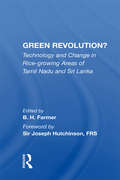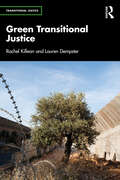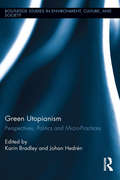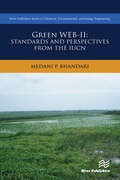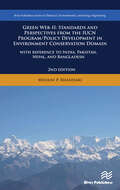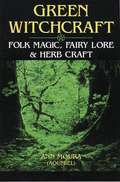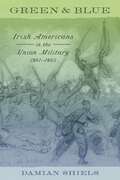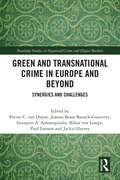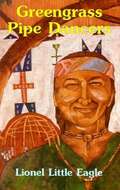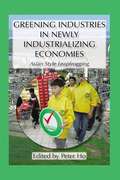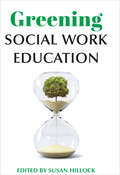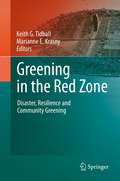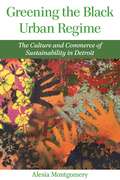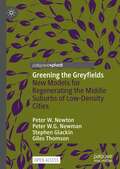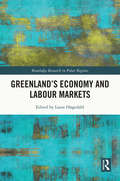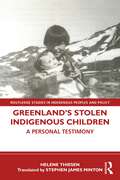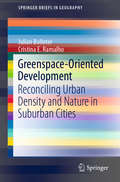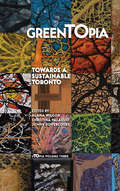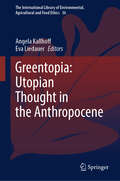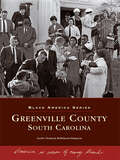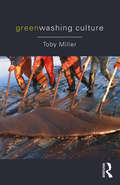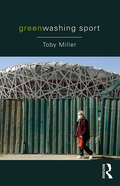- Table View
- List View
Green Revolution?: Technology And Change In Rice-growing Areas Of Tamil Nadu And Sri Lanka (Cambridge Commonwealth Ser.)
by B. H. Farmer Joseph HutchinsonAs will be made clear in the pages that follow, this book is based on a field research project focused on rice-growing and undertaken in parts of North Arcot District in Tamil Nadu (India) and of Hambantota and Mon-eragala Districts, Sri Lanka. We use 'S.E. Sri Lanka' as shorthand for the whole of the latter study area, and 'Hambantota District' for the part of it which falls in that District. Except where the context requires otherwise, the present in our book refers to 1973-4; while 'Randam' and 'Paha-lagama' are fictitious names for real villages. The project was an inter-disciplinary one, involving workers qualified in economics, geography, hydrology, sociology, statistics and the study of the administration of development.
Green Ribbons and Turbans: Young Iranians Against the Mullahs
by Joanna Oseman Armin ArefiDuring the last presidential election in Iran, nonviolent protestors defied the mullahs' power by wearing green ribbons on their wrists. In June of 2009, the inhabitants of Tehran were living underground to escape the government's authority, strangled by interdictions, dreaming of freedom and revolution. Mahmoud Ahmadinejad, president of the Islamic Republic of Iran and desperate to maintain his power, defeated his opponent, Mahmoud Mousavi, by massive electoral fraud. The resulting frustration and anger throughout the country sparked a gigantic wave of opposition. The Green Movement was born.In this timely, politically relevant, and unique account of life in Iran, Arefi takes us to a world removed from the usual cultural and political clichés about Iran and lets us hear the voices of a new generation of Iranians, who have never known anything but religious dictatorship and repression. He also tells the stories of the first victims of repression-Neda, Sohrab, and Taraneh.
Green Transitional Justice (Transitional Justice)
by Rachel Killean Lauren DempsterThis book rethinks the boundaries of transitional justice, urging scholars and practitioners to confront the often-overlooked nexus between mass violence and ecological harm.Through an in-depth analysis of the field’s limitations – such as its anthropocentric legalism, neocolonial practices, and alignment with neoliberalism – the book critiques the historical marginalisation of Nature in transitional justice discourse and practice. It argues that ignoring environmental harm not only undermines the possibility of holistic justice but also perpetuates structural violence and inequality. In response, the book sketches a ‘greener’ transitional justice, integrating principles from environmental justice, Indigenous knowledge systems, and ecocentric perspectives. It explores the possibilities of recognising Nature as a victim of mass violence, adapting existing mechanisms to incorporate environmental harm, and fostering transformative approaches premised on the interdependence of human and ecological well-being.This book is written for students, researchers, and practitioners of transitional justice and fields related to conflict transformation, peacebuilding, environmental protection, and development.
Green Utopianism: Perspectives, Politics and Micro-Practices (Routledge Studies in Environment, Culture, and Society #2)
by Karin Bradley Johan HedrénUtopian thought and experimental approaches to societal organization have been rare in the last decades of planning and politics. Instead, there is a widespread belief in ecological modernization, that sustainable societies can be created within the frame of the current global capitalist world order by taking small steps such as eco-labeling, urban densification, and recycling. However, in the context of the current crisis in which resource depletion, climate change, uneven development, and economic instability are seen as interlinked, this belief is increasingly being questioned and alternative developmental paths sought. This collection demonstrates how utopian thought can be used in a contemporary context, as critique and in exploring desired futures. The book includes theoretical perspectives on changing global socio-environmental relationships and political struggles for alternative development paths, and analyzes micro-level practices in co-housing, alternative energy provision, use of green space, transportation, co-production of urban space, peer-to-peer production and consumption, and alternative economies. It contributes research perspectives on contemporary green utopian practices and strategies, combining theoretical and empirical analyses to spark discussions of possible futures.
Green Web-II: Standards and Perspectives from the IUCN (River Publishers Series In Chemical, Environmental, And Energy Engineering Ser.)
by Medani P. BhandariIn dealing with the IUCN, one must bear in mind that there never has been, and undoubtedly never will be, any other organization even remotely resembling it. Its peculiarities, subtleties and complexities are sometimes mind-boggling (Nicholson 1990 in Holdgate 1999: ix). Green Web-II investigates IUCN's role in global biodiversity conservation policy as well as in national program development in India, Pakistan, Nepal and Bangladesh. It explores how nature protection priorities and approaches are promoted or addressed by IUCN, an international organization, and how environment conservation policies are created and maintained in states with different capacities of South Asia. It also evaluates IUCN's competency in bio-diversity, climate change, nature conservation and environmental policy formulation at global, regional and country level. This study is the first detailed scholarly study on the IUCN as an organization as well as on its efforts in biodiversity conservation. This book adds to our knowledge, firstly by contributing to a small but growing body of work on the sociology of international organizations. IOs, especially International Governmental Organizations (IGOs), have long been the subject of mostly political science. Secondly, it applies a fuller sociological imagination to the study of IOs by critically exploring one of the largest and most active nature conservation organizations in the world. Thirdly, it also explores how the IUCN actually goes about building protectoral programs with individual member nations. Additionally, the book explores the recent development of the green economy (GE) concepts into IUCN's program planning today. The green economy initiative applies a people-first approach. Although the concept is relatively new, this research explores the theoretical development of a green economy and illustrates how this theory is applied in IUCN's program planning to program implementation.
Green Web-II: Standards and Perspectives from the IUCN Program / Policy Development in Environment Conservation Domain - with reference to India, Pakistan, Nepal, and Bangladesh
by Medani P. BhandariThis second edition of the book, “Green Web-II: Standards and Perspectives from the IUCN Program / Policy Development in Environment Conservation Domain- with reference to India, Pakistan, Nepal, and Bangladesh” investigates the IUCN’s role in global biodiversity conservation policy as well as in national program development in India, Pakistan, Nepal and Bangladesh. It explores how nature protection priorities and approaches are promoted or addressed by IUCN, and how environment conservation policies are created and maintained in states of South Asia with different capacities. It also evaluates IUCN's competency in biodiversity, climate change, nature conservation and environmental policy formulation at the global, regional and country levels.This book adds to our knowledge firstly by contributing to a small but growing body of work on the sociology of international organizations. International Governmental Organizations (IGOs), have previously been mainly the subject of political science. Secondly, it critically explores one of the largest and most active nature conservation organizations in the world. Thirdly, it also explores how IUCN actually goes about building protectoral programs with individual member nations. Finally, the research also shows the historical development of global institutions and IUCN’s activities with member nations in helping to define or redefine the concept of global governance. The outcomes of this research will also be beneficial for global collaboration, networking, and for the identification of common concerns among the many environmental and conservational organizations at the international and national level. In this broader sense, the research outcomes might be beneficial to constituencies of the global North as well as global South because of the nature and coverage of IUCN and its role in conservation policy formation. This effort may serve as a model for additional research on international organizations.Technical topics discussed in the book include: The Motivation for Environmental Conservation- How personal efforts make a difference The Role of International Environment Conservation Organizations The Political Economy of Organizations, Network theory, Institutional theory, Stakeholder theory, Governance theory Governance performance and Competitiveness Popularity indices Knowledge creation and diffusion Conservation commons
Green Witchcraft: Folk Magic, Fairy Lore, & Herb Craft
by Ann MouraLearn the basics of Witchcraft from a third-generation Witch raised in a family tradition. Positive, practical, and easy to use, Green Witchcraft brings together the best of both modern Wicca and the author's family heritage of herb craft and folk magic. Green Witchcraft explores the fundamentals of the Wiccan religion, providing magical training for the independent thinker. Step-by-step instructions on a wide variety of magical techniques as well as basic rules of conduct make this the ideal book to get you started. Green rituals for self-initiation, rites of passage, seasonal celebrations and activities provide an excellent foundation for your own magical tradition. Discover the fine art of spell-casting, the magical uses of herbs, divination with the tarot and more. Explore the Sabbats, Esbats, and other rituals attuned to the cycles of nature and the universal powers. Find out for yourself what this organic approach to Witchcraft is all about.
Green Zone: Imperial Life in the Emerald City
by Rajiv ChandrasekaranFrom inside a surreal bubble of pure Americana known as the Green Zone, the US-led Coalition Provisional Authority attempted to rule Iraq following the fall of Saddam Hussein's regime. Drawing on interviews and internal documents, Rajiv Chandrasekaran tells the memorable story of this ill-prepared attempt to build American democracy in a war-torn Middle Eastern country, detailing not only the risky disbanding of the Iraqi army and the ludicrous attempt to train the new police force, but absurdities such as the aide who based Baghdad's new traffic laws on those of the state of Maryland, downloaded from the net, and the twenty-four-year-old who had never worked in finance put in charge of revitalising Baghdad's stock exchange. Imperial Life in the Emerald City is American reportage at its best.
Green and Blue: Irish Americans in the Union Military, 1861–1865 (Conflicting Worlds: New Dimensions of the American Civil War)
by Damian ShielsDamian Shiels’s Green and Blue explores Irish American service in the United States military by analyzing the written correspondence of ordinary rank-and-file soldiers drawn from across the Union’s armed forces. Using a vast and largely untapped collection of letters penned by Irish American combatants to their families during the war, Shiels explains how these enlisted men navigated their duties from multiple perspectives, including how they adapted to and experienced military life, how they engaged with their faith, and how they interacted with the home front. Green and Blue offers the most detailed and intimate picture yet of Irish Americans’ service in the United States military during the Civil War.
Green and Transnational Crime in Europe and Beyond: Synergies and Challenges (Routledge Studies in Organised Crime)
by Georgios A. Antonopoulos Klaus Von Lampe van Duyne, Petrus C. Joanna Banach-Gutierrez Paul Larsson Jackie HarveyThis book brings together research and studies in the fields of organised crime and of ‘green criminality’ against the natural environment. By bringing the research traditions of organised crime and ‘green criminology’ into closer proximity and combining contributions on traditional organised crime and ecological crime in one volume, it questions the need to draw artificial dividing lines between criminological sub-disciplines. Including chapters on the illegal trade in cobalt, in stolen motor vehicles, the illegal dog market, cross- border amber trafficking, deforestation and environmental harm in the Norwegian industrial salmon farming, the book offers an important rapprochement between studies in organised crime and green criminology, and considers the operational differences between underworld and upperworld criminal economies.
Green: A Field Guide to Marijuana
by Dan Michaels ChristiansenGreen: A Field Guide to Marijuana is required reading for a new generation of curious and sophisticated pot smokers. Presented in an eye-popping package and filled with hyperdetailed photography of individual buds, this essential guide to marijuana is smart, practical, and exceedingly beautiful. The "Primer" section explores the culture of this complex flower and explains the botany that makes each strain unique. The "Buds" section describes the variations of lineage, flavor, and mental or physical high that define 170 exceptional strains. Poised to become the go-to marijuana guide for recreational and medicinal users alike, Green is easy to pick up and impossible to put down.
Greengrass Pipe Dancers: Crazy Horse's Pipe Bag and a Search for Healing
by Lionel Little EagleThe saga of Crazy Horse's pipe bag, given to Dr. Henry Alexander Brown by the Lakotas, is recounted through amazing stories of its often uncanny power and the rich legacy behind it.
Greening Industries
by HoFirst published in 2006. Routledge is an imprint of Taylor & Francis, an informa company.
Greening Social Work Education
by Susan HillockDespite urgent calls for global action, sustainable social work practice, and a solid “green” theoretical knowledge base, North American social work and helping professions have been slow to learn from community activists, acknowledge the international climate emergency, and act collectively to achieve climate justice. Greening Social Work Education examines how social work educators can best incorporate sustainability content into social work curricula, integrate green teaching methods, and mobilize students and colleagues towards climate action, justice, and leadership. Drawing on Canadian content, this collection highlights Indigenous, eco-feminist, collective-action, and multi-interdisciplinary approaches to social work. The book provides a rationale for why the topic of greening is important for social work and the helping professions; discussion of current debates, tensions, and issues; useful ideas related to innovative interdisciplinary theoretical approaches, analyses, and constructs; and practical recommendations for teaching green social work education. In doing so, Greening Social Work Education strives to help social workers and educators gain the confidence and tools they need to transform their teaching and curricula.
Greening in the Red Zone: Disaster, Resilience and Community Greening
by Marianne E. Krasny Keith G. TidballCreation and access to green spaces promotes individual human health, especially in therapeutic contexts among those suffering traumatic events. But what of the role of access to green space and the act of creating and caring for such places in promoting social health and well-being? Greening in the Red Zone asserts that creation and access to green spaces confers resilience and recovery in systems disrupted by violent conflict or disaster. This edited volume provides evidence for this assertion through cases and examples. The contributors to this volume use a variety of research and policy frameworks to explore how creation and access to green spaces in extreme situations might contribute to resistance, recovery, and resilience of social-ecological systems.
Greening the Black Urban Regime: The Culture and Commerce of Sustainability in Detroit (Great Lakes Books Series)
by Alesia MontgomeryAlesia Montgomery’s Greening the Black Urban Regime: The Culture and Commerce of Sustainability in Detroit tells the story of the struggle to shape green redevelopment in Detroit. Cultural workers, envisioning a green city crafted by direct democracy, had begun to draw idealistic young newcomers to Detroit’s street art and gardens. Then a billionaire developer and private foundations hired international consultants to redesign downtown and to devise a city plan. Using the justice-speak of cultural workers, these consultants did innovative outreach, but they did not enable democratic deliberation. The Detroit Future City plan won awards, and the new green venues in the gentrified downtown have gotten good press. However, low-income black Detroiters have little ability to shape "greening" as uneven development unfolds and poverty persists. Based on years of fieldwork, Montgomery takes us into the city council chambers, nonprofit offices, gardens, churches, cafés, street parties, and public protests where the future of Detroit was imagined, debated, and dictated. She begins by using statistical data and oral histories to trace the impacts of capital flight, and then she draws on interviews and observations to show how these impacts influence city planning. Hostility between blacks and whites shape the main narrative, yet indigenous, Asian, Arab, and Latinx peoples in Detroit add to the conflict. Montgomery compares Detroit to other historical black urban regimes (HBURs)—U.S. cities that elected their first black mayors soon after the 1960s civil rights movement. Critiques of ecological urbanism in HBURs typically focus on gentrification. In contrast, Montgomery identifies the danger as minoritization: the imposition of "beneficent" governance across gentrified and non-gentrified neighborhoods that treats the black urban poor as children of nature who lack the (mental, material) capacities to decide their future. Scholars and students in the social sciences, as well as general readers with social and environmental justice concerns, will find great value in this research.
Greening the Greyfields: New Models for Regenerating the Middle Suburbs of Low-Density Cities
by Peter W. Newton Peter W.G. Newman Stephen Glackin Giles ThomsonThis open access book outlines new concepts, development models, governance and implementation processes capable of addressing the challenges of transformative urban regeneration of cities at precinct scale.
Greenland's Economy and Labour Markets (Routledge Research in Polar Regions)
by Laust HøgedahlThis book explores structural changes in Greenland’s economy and labour markets due to the transformative effects of climatic changes and growing international attention. It offers multidisciplinary perspectives from economists, sociologists, and political scientists to demonstrate how the Greenlandic economy works. Due to an increasing focus on the Arctic area and Greenland in particular, the book seeks to understand the functioning and dynamics of Greenland’s labour economy, as well as the challenges that arise from the melting ice and internationalisation. It fills a substantive gap in the existing literature by compiling research on these critical subjects and exploring current and future opportunities for labourers. Today, Greenland is reliant on large financial subsidies from Denmark to provide for a large share of its national budget. This fuels Greenland’s political ambition to gain greater independence from Denmark, which requires more private sector growth to develop a sustainable economy. This book thus contains an exhaustive introduction to important business development themes such as macroeconomics, markets, labour supply, labour market policies, and institutions and considers Greenland’s colonial past, great Inuit heritage, and unique geography and nature to re-shape its economy and labour markets. Informed by a lucid writing style, each chapter casts light on different economic and social issues of Greenland. This is the first international book on Greenland’s economy which discusses its geopolitical importance and prospects for the Arctic region. It will be a valuable point of reference for students and academics of economics, Arctic research and political economy.
Greenland’s Stolen Indigenous Children: A Personal Testimony (Routledge Studies in Indigenous Peoples and Policy)
by Helene ThiesenIn this book, author Helene Thiesen recounts her experience of being removed from her family in Greenland as a young Inuk child, to be ‘re-educated’ in Denmark and an orphanage in Greenland. The practice of forcible assimilation of Indigenous children into colonial societies through ‘education’ has echoes in North America and Australasia, and the painful legacy of these practices remains under-acknowledged. In this poignant book, Helene recounts in detail the process of being taken from her family in 1951, aged seven, along with twenty-one other children, in the attempt to re-make them into ‘model Danish citizens’, in a social ‘experiment’ led by the Danish government and Save the Children Denmark. When the children returned to Greenland a year and a half later, they were sent to live in a Danish Red Cross orphanage, where they were forbidden to speak their native languages, and were compelled to adopt Danish language, culture and customs. With a detailed introductory analysis from Dr Stephen James Minton, who also provides the translation, Helene’s account serves as a compelling and powerful testimony of a devastating colonial experiment. Richly illustrated with forty photos to help to situate the reader, this book provides an invaluable case study for researchers and students in the fields of Indigenous Studies, Critical Pedagogy and Education, Psychology, European History, and Cultural Studies.
Greenspace-Oriented Development: Reconciling Urban Density and Nature in Suburban Cities (SpringerBriefs in Geography)
by Julian Bolleter Cristina E. RamalhoTransit-Oriented Development (TOD) planning principles have informed Australian city planning for over two decades. As such, policy makers and planners often unquestioningly apply its principles. In contrast, this book critiques TOD and argues that while orientating development towards public transport hubs makes some sense, the application of TOD principles in Australia has proven a significant challenge. As a complementary strategy, the book stakes out the potential of Greenspace-Oriented Development (GOD) in which urban density is correlated with upgraded green spaces with reasonable access to public transport. Concentrating urban densification around green spaces offers many advantages to residents including ecosystem services such as physical and mental health benefits, the mitigation of extreme heat events, biodiversity and clean air and water. Moreover, the open space and leafy green qualities of GOD will ensure it resonates with the lifestyle aspirations of suburban residents who may otherwise resist urban densification. We believe in this way, that GOD could be an urban dream that befits the challenges of this 21st century.
Greentopia: Towards a Sustainable Toronto (uTOpia)
by Jonny Dovercourt Alana WilcoxGardening the Gardiner. Hydrogen-fuelled cabs. Rooftop Power. Rainwater harvesting. A new model of taxation. The art of salvage. Drinking less coffee. Composters for dog poo in city parks. Ravine City.What would make Toronto a greener place?This third book in the uTOpia series asked imaginative Torontonians to think both big and small about how we might make our city more environmentally wise and responsible. They responded with immodest proposals and how-to tips, thoughtful considerations and flights of fancy that just might work. They wrote essays long and short, taking stock of how far weve come in the struggle to green ourselves and providing suggestions for simple actions with big effects. Their ideas sometimes playful, sometimes pie-in-the-sky offer brazen new perspectives on transportation, garbage, trees, energy, water, animals and green space and arrive at imaginative and ingenious solutions to the problems plaguing all modern cities.GreenTOpia features a resources section, including profiles of key eco-friendly groups in the GTA, a directory of green organizations, as well as a how-to guide and a fun-facts section.
Greentopia: Utopian Thought in the Anthropocene (The International Library of Environmental, Agricultural and Food Ethics #36)
by Angela Kallhoff Eva LiedauerGreentopia: Utopian Thought in the Anthropocene provides new ways of imagining the future interface between society and non-human nature and brings into focus the possibility of a peaceful coexistence. “Greentopia” is a mode of thought that takes us beyond mourning environmental degradation and ecological catastrophe. The absence of already-paved paths in the area gives space for a variety of experiments in thinking. The book interprets its subject, “Greentopia”, as a method of re-imagination, yet also as a very concrete practice. It brings together researchers from different areas to investigate environmental utopia from their respective angles. The present volume is of highest interest for environmental ethicists, but also of interest for anyone involved in current discourses on utopianism, life in the Anthropocene, environmental crises, the future of agriculture and green cities.
Greenville County, South Carolina (Black America Series)
by Leola Clement Robinson-SimpsonCradled at the foothills of the beautiful Blue Ridge Mountains and once known as the "Textile Center of the South," Greenville has evolved into a prosperous hub for corporate development and global commerce. Greenville County's African American community, proud and resourceful, has strong roots dating back to 1770, when blacks helped to carve the county out of an upstate wilderness. The experiences of the black community and its long relationship with whites up to the civil rights movement helped to create the climate for the kaleidoscope of races and cultures in Greenville today.
Greenwashing Culture
by Toby MillerGreenwashing Culture examines the complicity of culture with our environmental crisis. Through its own carbon footprint, the promotion of image-friendly environmental credentials for celebrities, and the mutually beneficial engagement with big industry polluters, Toby Miller argues that culture has become an enabler of environmental criminals to win over local, national, and international communities. Topics include: the environmental liabilities involved in digital and print technologies used by cultural institutions and their consumers; Hollywood's 'green celebrities' and the immense ecological impact of their jet-setting lifestyles and filmmaking itself; high profile sponsorship deals between museums and oil and gas companies, such as BP's sponsorship of Tate Britain; radical environmental reform, via citizenship and public policy, illustrated by the actions of Greenpeace against Shell's sponsorship of Lego. This is a thought-provoking introduction to the harmful impact of greenwashing. It is essential reading for students of cultural studies and environmental studies, and those with an interest in environmental activism.
Greenwashing Sport
by Toby MillerProfessional sports promote their green credentials and yet remain complicit in our global environmental crisis Sports are responsible for significant carbon footprints through stadium construction and energy use, player and spectator travel, and media coverage. The impact of sports on climate change is further compounded by sponsorship deals with the gas and petroleum industries—imbuing those extractive corporations with a positive image by embedding them within the everyday pleasure of sport. Toby Miller argues that such activities amount to "greenwashing". Scrutinizing motor racing, association football, and the Olympics, Miller weighs up their environmental policies, their rhetoric of conservation and sustainability, and their green credentials. The book concludes with the role of green citizenship and organic fan activism in promoting pro-environmental sports. This is a must-read for students and researchers in media, communications, sociology, cultural studies, and environmental studies.
